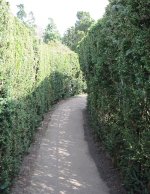The Gardens



By markle
- 3508 reads
“a green thought in a green shade”
--Andrew Marvell
Only the sign meets you at the gate. ALL VISITORS MUST PURCHASE A TICKET. You feel your whole face go into the frown – it must be heat weighing on the skin. Either side of the gate the cake-brown façade of the front block extends to the limit of the gravel drive. Then trees, and a stretch of downland.
No one else. You should be used to making these trips on your own now. Your clothes hang heavy in the frustration of having arrived, but there being only this sign. At last you see, off to the right, the roll of tickets – rough paper, like the numbers at a school raffle – on a stone pillar with a strong-box slotted into its face.
According to a smaller, lesser sign, you do not have the right change for the entry fee. No one’s looking, you could walk right in or just take a ticket, keep the money. But the heat drains that swell of boldness out. Or the silence does.
Behind you, the long driveway stretches dusty white to the road. Yours is the first car in the scratch of a car park a little way down. In these dog days there are no birds, and if any breeze touches the green on either side of you, it does so with great gentleness.
To pretend your hesitation is no such thing, you study the keystone of the entrance arch in front of you. The whole building has a blank orderliness. Straight lines, square corners, and here and there a mythic head.
The keystone seems set up to carry a face – Athena, Ceres or someone – but it’s bare, a jutting stone carrying the weight of the arch.
Odd how an assertive sign carries more weight than one that simply lists the rules. You put some money in the strongbox – not quite enough to meet the listed price, but at least you have purchased a ticket. You tear one from the end of the roll.
It clings to sweaty fingers and will not easily stay in your pocket. Suddenly you worry that it has blown away, or that the moisture has defaced it, so that any zealous attendant on the other side can turn you out, back down the drive to the road.
Is it the embarrassment of such a dismissal that worries you? Or the possible injustice? You have purchased a ticket. You wipe your hand, check that the ink has not blotched and fold the ticket in with the cash you have left. For a moment you had forgotten there was no one else here.
An interval of shadow – it’s dusty in the passageway, but cooler than the white stone of the driveway – and you are back in the heavy sun. Something else now – the thick, thick smell of flowers. Immediately they confront you, red petals strung with orange, glossy, almost slumped on the tightly trimmed border hedge, as if drowsy or drunk.
There is always some disorder in a garden – here a stray end, here a bloom that’s gone too fast and is drying out, here a white bird dropping. That is true here, except that you’ve never seen a place where these irregularities have been kept so few.
Each white path is lined with rectangular-cut hedge. Beyond each hedge stands each set of flowers: at first the red, next the blue and yellow mix, and third the white, great trumpeted blossoms like an brass band. This space is tightly enclosed in a brick wall, whose date, you suspect, precedes that of the gatehouse. Espaliered trees hold their backs tight to it. Their leaves are dark green at this time of year. The branches seem to bear no fruit.
You are reassured by insects. Bees move slowly, irregularly from flower to flower. Their wings vibrate the petals. Every so often one lifts itself vertically into the steady blue overhead. Its sound disappears.
You have been expecting to see an attendant emerge somewhere from the foliage. An elderly lady in a blanket-like jacket despite the weather, or a slight old man stooping to one side. Either one would be wearing a sash over one shoulder, and in one hand carry a sheaf of leaflets – possibly a map of the grounds. You regret now not looking for one of those at the gate. The air seems closer to a liquid than a gas, and your eyes are struggling to make sense of the dimensions of this walled garden. But you are reluctant to retrace your steps this early. There probably aren’t any maps out there anyway.
No attendant appears. Perhaps there’ll be a gardener up a ladder. On quiet days like this, they’ll be doing all the maintenance. You imagine a tight-lipped woman approaching, with shears swinging from her hand. She is sure to check the ticket – this garden is her work, and the dry weather has made her irritable. You can feel your face shaping into an apologetic grin.
You mean to ask for directions, but you don’t have any sense of where you want to go. Your only point of reference is the gateway. You want to put her at ease, comment on the number of insects despite the chemicals that must be needed to keep the garden so precise.
You realise that you are chattering to yourself. It’s the heat. You go a few steps on, and see a gap in the red wall.
Everything is greener on the further side. Trees ring your vision. The white gravel of the path looks the same, but doesn’t feel so hot. Your head clears, and again you look round for an attendant or a gardener. It’s still strange to be here without anyone you could comment to about how strange it is to be here alone.
Following this line of thought, you check your phone. There’s no signal. Perhaps it’s the high walls, or the garden’s location in a bowl of hills. The battery’s low too. Probably the heat draining it. You switch the phone off, in case you need it later. Or you could go back to the car, which you briefly imagine reflecting the sunlight, and plug into the charger.
No, not yet. You’ve only just come in, and you’d like to see the house. You remember reading about its architecture, its significance to some family or other, but it was the gardens that seemed more interesting. An idea of a grand west wing drifts into your mind, and now you know what directions you’ll ask of the tight-lipped gardener.
The white path stretches up the slope in a straight line broken up by short flights of steps. It at first seems to branch off, once after every flight of steps, into paths left and right separated by high, well-trimmed hedges.
But it quickly becomes clear that the off-branches only lead as far as statues set in the curved ends of the hedgerows. In strange contrast with the clear white path, the scrubbed steps, the rigorously pruned hedges, each statue is planted round with saplings, whose leaves half-obscure the forms.
Even without a breeze, the overlay of foliage on shadow on stone gives movement on the edge of your vision. You keep thinking it’s an attendant, the gardener, a face you really want to recognise. You turn off the main path, determined to see a statue clearly.
It is discoloured, the surface grimed. It is of Daphne being turned into a laurel. The next one – you have to hold a branch aside, its smooth bark slipping against your fingers – is Actaeon being transformed into a stag. They are all, you conclude after checking a few more, metamorphoses. It makes you slightly uneasy, thinking of all those bodies being wrenched from one form to another, forever. You are glad to reach the top of the path.
You would expect an even grander artwork at the end of this parade, but all that confronts you is a stand of trees, which extends into deeper greenness on the left, and goes into the blue sky on the right. A signpost would have been more welcome than an artwork.
You stand for ages at this junction. You reason with yourself that in the end it makes no difference, you will be going round everything in the end. A word from someone would have settled the choice immediately.
Finally you drift right. You think you hear water on the left, but you’re not sure if it’s real. You do know there’s blue sky further along the path you’ve chosen. You check the ticket in your pocket again, slightly nervous in case it’s got sweaty and smudged. It has, but anyone who checked would still be able to read it.
The path proves steeper than you expect. The trees are wider spread. There’s not a bird sound among them. The grass between them is rigorously mown. Even with a motor mower it must surely take dozens of gardeners. They can’t all be tight-lipped women of about your own age.
The fact that you are toiling uphill makes you vaguely hopeful of finding the house – and so getting a sense of the shape of the garden. You imagine the house owners wanting a sense of command over their territory, waving a hand full of possession above the trees and the wall tops. What you want is a clearer sense of the way back to the gate.
You’re sure that you could get there if you needed to, but the route is a little hazy, and the spaces between the trees seem deeper, greener than they should. You stop to get the water bottle from your bag. How dry your throat had got, hardly possible to speak, if anyone had been listening.
This is beginning, you think, to take the shape of an anecdote you’d tell someone in a busy bar. You can imagine them smiling into their drink, rolling their eyes at the way you describe your blundering around.
“… and there was no one there!”
The words are in our voice, but you don’t know how you said them – in a clear tone, with a laugh in it, or tucked into the back of your head.
There’s a deadness in your muscles now you have come back to the edge of the trees from the bar. The white gravel remains underfoot, and reflects the sun with added grit.
A flight of geese passes over. Their shadows flutter on the swath of grass ahead of you. Their calls to each other shock you. What can they have to say?
They are moving on. You have come to a stop. Beyond the trees the sky is far greater than the blue lift shaft you remember from the walled garden. The hill tops and tree lines that mark its border are filled in a deeper shade than the valley right in front of you, whose colour is a sort of gleam, not a pigment or a dye.
In all this space there is no room for a response to your gaze. No houses, roads, tractors, nothing you can see, except the sheared heads of the grass stems and the statue halfway down the hill. You believe there is a little wear in the grass that you can follow to bring you directly to its plinth. You take this half path, slipping once or twice – this is not quite the surface you had chosen your shoes for.
Who is it dying? Or is it ecstasy? You don’t recognise the myth in this solitary statue. Even the gender of the body is hard to tell. Too much rain and sun on the stone, and even the face is pocked away. But the wrenching remains in the form.
You stare a while, catching your breath. It’s odd that such a thing is left to decay so much in this parkland. You look into the curve of the valley, where trees form an uneven line, probably along a small river. That must have been the source of the earlier sound. All that remains is to loop back round. You were right, you nod insistently.
But then you see statues on the far side of those trees. There must be a footbridge down there. That loop back you had fixed on would only be a short way round, missing out a grand, swooping vista of the gardens. Their boundary must be further on. You intend to see everything – you have purchased a ticket.
You are scorched as you go down the slope. The perfect green of the grass is marred by yellow, the stalks of desiccation. Halfway between the statue and the trees you stop, to get your breath back in the dry heat. The hillside is all sheened with light. If it weren’t for the stillness, you might imagine it on fire. It’s as though the flames cannot be reached – if you went close, looking for them, they could not be found. You’d be untouched for ever in the centre of the blaze.
The trees behind, and the statue, remain unchanged. They are still waiting. The object of desire, of longing, remains somewhere beyond the boundary fence, perhaps travelling the high-hedged fields in a car, alone.
You take a gulp of water, wipe the sweat out of your eyes, check the ticket in your pocket. You look down towards the line of trees, think yourself into their shade through the barrier of the ache in your feet, and calves, and shoulders.
You are under the trees. A narrow path runs along the stream bank. The trees seem to cast their own light, soft and thick. You can see dust particles slowly falling, as if in water. It has taken you a moment to realise that you are on your knees.
There is a hand supporting you. It is stained with sap, with earth, with mortar grit; it is tanned, the nails are cut right back. It is the gardener’s. You turn towards her. Her face is the path, stretching, stream-long and away, back into the sunlight.
- Log in to post comments
Comments
the description is wonderful
the description is wonderful - infused with a sense of magic and slight menace. A really enjoyable read - thank you!
- Log in to post comments
Wonderful descriptions and
Wonderful descriptions and that real sense of menace you get when you are somewhere there should be lots of other people, and there aren't.
- Log in to post comments
You can smell the flowers and
You can smell the flowers and feel the hairs rise on the back of your neck - this is our Facebook and Twitter Pick of the Day! Please share/retweet if you've enjoyed it.
Picture: http://tinyurl.com/y7cs8hpu
- Log in to post comments
I really enjoyed reading and
I really enjoyed reading and felt as if I were there with all your wonderful descriptions.
Jenny.
- Log in to post comments
Oooh this is like a dream,
Oooh this is like a dream, with a dark ending or worse still, no ending at all. Very intriguing.
- Log in to post comments
I'll remember this the next
I'll remember this the next time I have a wander round a garden. Deliciously unsettling.
- Log in to post comments
This touch of dark in the
This touch of dark in the green shade is our story of the week - Well done!
- Log in to post comments


